1976-77 - Rockwell College
Jim's ballooning history
[Click on thumbnails to see full size pictures]
|

|
I attended boarding school at Rockwell College in my native Ireland from 1972 through 1977. [To avoid confusion for US readers, I should point out that "College" doesn't necessarily mean what in means in the US; this was a secondary school (high school)]. In early 1975, the College acquired a hot-air balloon, piloted by Fr. Des Reid, a staff member, mainly as an attraction for Camp Rockwell, the College's summer school program. For the academic year, the balloon was flown by Fr. Reid with the help of the members of the Rockwell Aviation Club, formed for that purpose. I was a member for my last two years at Rockwell.
The balloon arrived in the Spring of 1974, and I recall late afternoons and early evenings in study hall, hearing the blast of the burner as Fr. Reid was doing his training flights, and wishing it was September already, when I would be eligible to join the newly-formed Aviation Club and get a chance to get close to the balloon!
Members of the Rockwell Aviation Club assembled for the year book photograph in 1976. Can you spot Jim without the receding hairline and bald patch? And, yes, the school dress code required ties...
|
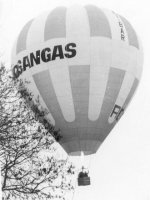
|
All of the black and white shots on this page are courtesy of Sean Morvan, who runs his family's chain of hotels on Jersey. In the color picture above, Sean is third from the right in the front row, wearing a tan sweater.
The Rockwell balloon, EI-BAR, originally G-BCAM, a Thunder AX-8 105. The balloon is still registered, according to a recent search of the Irish aircraft registry via Landings.com. I wonder if it's still airworthy.
|
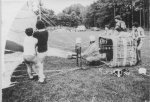
|
A shot of Fr. Reid at the start of a hot inflation. As you can see in this picture, the balloon originally had a single burner. Burners of that vintage were several times less powerful than today's models, and this 105,000 cubic foot balloon was probably underpowered even by the standards of the day. In fact, soon afterward, the burner was replaced with a double burner.
|
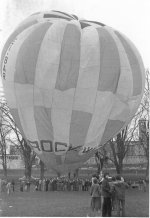
|
The balloon just about to stand up. As you can see, lack of crew was never a problem, with a lot of competition for the plum crew spots such as "Cremation Charlie." Just as well, too, since we didn't have a fan, and cold inflation was always done by flapping the mouth of the balloon!
|
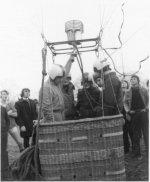
|
Here Fr. Reid burns to get the balloon light, while the four eager passengers (and some hopeful future aeronauts) look on.
We always wore crash helmets for launch and landing. This was partly due to the typically windy Irish weather (my first ever stand-up landing in a balloon was during my first flight with Santo, all my other landings having been drag-out affairs to one degree or another) and partly because of the flexible suspension, which can cause the burner to smack you on the head if the pilot happens to lose his grip on it during landing!
|
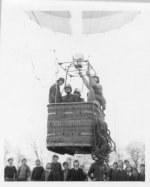
|
Lift-off!
|
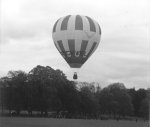
|
The balloon clears the trees by the playing fields at the College, a popular launch site. Notice that the balloon now has a double burner. This was a pre-parachute Velcro-top balloon with a side maneuvering vent; you can see the triangular side vent clearly in this picture.
|
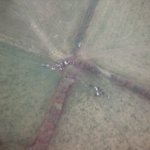
|
The cows don't seem to mind too much as we pass over them, despite the lack of a quieter liquid-fire flame. Most of our flying area, as you can see from this picture and the following one, was lush green farm fields, with almost unlimited landing spots. The main issue was always road access, and we did many carry-out retrievals across more than one field! There was one major red zone in our area, a stud farm owned by a major international thoroughbred racehorse breeder, and we were very careful always to gain lots of altitude if the winds were in that direction!
|
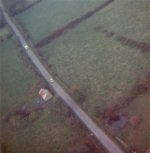
|
You can see our chase vehicle in the upper left corner of this shot. Again, lots of available landing sites. The only problem in Ireland, aside from the breezy conditions, was lots of low-tension power lines. There are often power lines running through fields, as well as along the perimeter, so you have to be quite vigilant. These older lines are remnants of the original rural electrification programs in the mid-20th century.
|
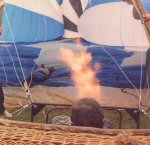
|
This sequence of 3 shots was recently sent to me by Nigel Reynolds, who attended Rockwell from 1977-1980.
Inflation fans were not in widespread use at that time, so inflations were begun by flapping the mouth of the balloon to get some cold air inside. The hot inflation was carried out using short burns, and the help of a crew member, dubbed "Cremation Charlie", who would help work the hot air bubble up to the top of the balloon, and keep the fabric away from the flame. Sometimes, as in this picture, he would be called upon to lie down spreadeagled to keep bubbles of fabric from billowing into the flame from below.
|
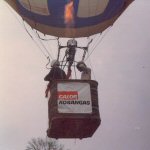
|
Up, up...
|
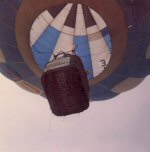
|
...and away!
|











